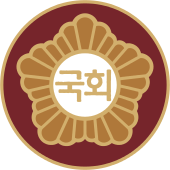Elections in South Korea
 |
| This article is part of a series on the politics and government of South Korea |
| Constitution |

|
|
Judiciary 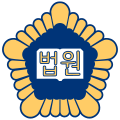
|
Elections in South Korea are held on national level to select the President and the National Assembly. Local elections are held every four years to elect governors, metropolitan mayors, municipal mayors, and provincial and municipal legislatures.
The president is directly elected for a single five-year term by plurality vote. The National Assembly has 300 members elected for a four-year term, 253 in single-seat constituencies and 47 members by proportional representation. Each individual party willing to represent its policies in the National Assembly is qualified on the legislative (general) election if: i) the national party-vote reaches over 3.00% on proportional contest or ii) more than 5 members of the party are elected from each of their first-past-the-post election constituencies.[1]
Since the 2016 legislative elections, South Korea has a three-party system, with two dominant parties and one major third party.[2][3]
Schedule
Election
| Position | 2017 | 2018 | 2019 | 2020 | 2021 | 2022 |
|---|---|---|---|---|---|---|
| Type | Presidential (December) | Gubernatorial (June) | None | National Assembly (April) | None | Gubernatorial (June) Presidential (December) |
| President | President | None | President | |||
| National Assembly | None | All seats | None | |||
| Provinces, cities and municipalities | None | All positions | None | All positions | ||
Inauguration
| Position | 2018 | 2019 | 2020 | 2021 | 2022 | 2023 |
|---|---|---|---|---|---|---|
| Type | Presidential (February) Gubernatorial (July) | None | National Assembly (July) | None | Gubernatorial (July) | Presidential (February) |
| President | February 25 | None | February 25 | |||
| National Assembly | None | July 1 | None | |||
| Provinces, cities and municipalities | July 3 | None | July 3 | None | ||
Latest elections
2016 legislative election
| Parties | Local seats | ± | Block seats | ± | Constituency votes | % | PR block votes | % | Total seats | ± | |
|---|---|---|---|---|---|---|---|---|---|---|---|
| Minjoo Party of Korea (더불어민주당) (MPK) 1 | 110 | | 13 | | 8,881,369 | 37.0% | 6,069,744 | 25.5% | 123 | | |
| Saenuri Party (새누리당) (SP) 2 | 105 | | 17 | | 9,200,690 | 38.3% | 7,960,272 | 33.5% | 122 | | |
| People's Party (국민의당) (PP) | 25 | (new) | 13 | (new) | 3,565,451 | 14.9% | 6,355,572 | 26.7% | 38 | (new) | |
| Justice Party (정의당) (JP) 3 | 2 | | 4 | | 395,357 | 1.6% | 1,719,891 | 7.2% | 6 | | |
| Christian Liberal Party (기독자유당) (CLP) | 0 | (new) | 0 | (new) | 1,376 | 0.0% | 626,853 | 2.6% | 0 | (new) | |
| Minjoo Party (민주당) (MP) 4 | 0 | (new) | 0 | (new) | 17,034 | 0.1% | 209,872 | 0.9% | 0 | (new) | |
| Other parties | 0 | | 0 | | 257,879 | 1.1% | 818,773 | 3.4% | 0 | | |
| Independents | 11 | | N/A | 1,683,264 | 7.0% | N/A | 11 | | |||
| Total | 253 | 47 | 24,002,420 | 100.0% | 23,760,977 | 100.0% | 300 | ||||
| Turnout: 58.0%[6] | |||||||||||
Seat changes are compared to previous election, not the outgoing Assembly
1 Comparison based on 2012 Democratic United Party result
2 Comparison includes members elected in 2012 for the Liberty Forward Party
3 Comparison based on 2012 Unified Progressive Party result
4 Non-parliamentary grouping: not to be confused with the larger Minjoo Party of Korea, more usually referred to as the Minjoo Party
2014 local election
2012 presidential election
| Candidate | Party | Votes | % | ||
|---|---|---|---|---|---|
| Park Geun-hye | Saenuri Party | 15,773,128 | 51.55 | ||
| Moon Jae-in | Democratic United Party | 14,692,632 | 48.02 | ||
| Kang Ji-won | Independent | 53,303 | 0.17 | ||
| Kim Soon-ja | Independent | 46,017 | 0.15 | ||
| Kim So-yeon | Independent | 16,687 | 0.05 | ||
| Park Jong-sun | Independent | 12,854 | 0.04 | ||
| Invalid/blank votes | 126,838 | – | |||
| Total | 30,721,459 | 100 | |||
| Registered voters/turnout | 40,507,842 | 75.84 | |||
| Source: National Election Commission | |||||
Summary of past elections
Presidential elections
Winning party ideology: Conservative · Liberal · Independent
| # | Year | Winner | 2nd | 3rd | Notes | |
|---|---|---|---|---|---|---|
| First Republic | ||||||
| President and Vice President elected indirectly by the National Assembly[7] | ||||||
| 1 | 1948 | 
Syngman Rhee |

|
In the vice-presidential election, Yi Si-yeong (NARRKI) won over Kim Koo by 57.4% to 33.0%. | ||
| President and Vice President elected by popular vote | ||||||
| 2 | 1952 | .jpg)
Syngman Rhee |

Cho Bong-am |

|
The election took place during the Korean War. In the vice-presidential election, independent Ham Tae-young won the election with 41.3%, defeating Liberal candidate Lee Beom-seok (25.5%) and Democratic Nationalist Chough Pyung-ok (8.1%). | |
| 3 | 1956 | 
Syngman Rhee |

Cho Bong-am |
In the vice-presidential election, Democratic Party candidate Chang Myon defeated Lee Ki-poong (Liberal) by 46.4% to 44.0%. | ||
| – | Mar 1960 |

Syngman Rhee |
Rhee re-elected unopposed due to the death of his Democratic Party opponent Chough Pyung-ok. In the vice-presidential election, Lee Ki-poong (Liberal) won with 79.2% over Chang Myon (Democratic) with 17.5%. The results of both elections were annulled as fraudulent after the April Revolution. | |||
| Second Republic | ||||||
| President elected indirectly by both houses of the National Assembly; Vice Presidency abolished | ||||||
| 4 | Aug 1960 |

Yun Bo-seon |
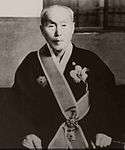
Kim Chang-sook |
The only presidential election of the Second Republic. | ||
| Third Republic | ||||||
| President elected by popular vote | ||||||
| 5 | 1963 | 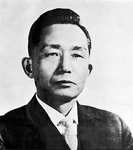
|

Yun Bo-seon |
First election after the May 16 coup. | ||
| 6 | 1967 | .jpg)
|

Yun Bo-seon |
|||
| 7 | 1971 | .jpg)
|

Kim Dae-jung |
|||
| Fourth Republic | ||||||
| President elected by the National Council for Reunification | ||||||
| 8 | 1972 | .jpg)
|
First election after the October Yushin. Park re-elected unopposed. | |||
| 9 | 1978 | .jpg)
|
Park re-elected unopposed. | |||
| 10 | 1979 | 
Choi Kyu-hah |
First election after Park Chung-hee's assassination. Acting President Choi elected as President unopposed. | |||
| 11 | 1980 | 
Chun Doo-hwan |
First election after the coup d'état of December Twelfth. Chun elected unopposed. | |||
| Fifth Republic | ||||||
| President elected indirectly | ||||||
| 12 | 1981 | 
|
DKP Yu Chi-song Democratic Korea (7.7%) |
The only presidential election of the Fifth Republic. | ||
| Sixth Republic | ||||||
| President elected by first-past-the-post popular vote with single-term limit | ||||||
| 13 | 1987 | 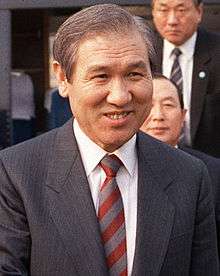
|

Kim Young-sam |
.png)
Kim Dae-jung |
First free and fair direct presidential election in South Korean history.[8] | |
| 14 | 1992 | 
|
.png)
Kim Dae-jung |
.jpg)
Chung Ju-yung |
||
| 15 | 1997 | .png)
|
.jpg)
Lee Hoi-chang |
NPP Lee In-je New People (19.2%) |
||
| 16 | 2002 | 
|
.jpg)
Lee Hoi-chang |
|||
| 17 | 2007 | .jpg)
Lee Myung-bak |

|
.jpg)
Lee Hoi-chang |
||
| 18 | 2012 | 
Park Geun-hye |

Moon Jae-in |
|||
Legislative elections
Winning party: Conservative · Liberal
1946 – 1948 – 1950 – 1954 – 1958 – 1960 – 1963 – 1967 – 1971 – 1973 – 1978 – 1981 – 1985 – 1988
| # | Year | First party | Status | Seat composition | Popular vote | Parties (in order of seats) | ||
|---|---|---|---|---|---|---|---|---|
| 14 | 1992 | Democratic Liberal Party | |
| ||||
| 15 | 1996 | New Korea Party | |
| ||||
| 16 | 2000 | Grand National Party | |
| ||||
| 17 | 2004 | Uri Party | |
| ||||
| 18 | 2008 | Grand National Party | |
| ||||
| 19 | 2012 | Saenuri Party | |
| ||||
| 20 | 2016 | Minjoo Party of Korea | |
|||||
Local elections
Notes
- ↑ Representation System(Elected Person), the NEC, Retrieved on April 10, 2008
- ↑ "People's Party opens the way to a real three party system". The Hankyoreh. 15 April 2016. Retrieved 15 April 2016.
- ↑ "Minority People's Party steals show: Ahn's Party holds balance of power as three party system dawns". The Korea Herald. 13 April 2016. Retrieved 15 April 2016.
- ↑ "4.13 총선" (in Korean). Naver News. 13 April 2016. Retrieved 13 April 2016.
- ↑ "개표진행상황" (in Korean). Republic of Korea National Election Commission. 14 April 2016. Retrieved 14 April 2016.
- ↑ "20대 총선 잠정투표율 58.0%…19대보다 3.8%p↑" (in Korean). Yonhap News. 13 April 2016. Retrieved 13 April 2016.
- ↑ Lee (1984), p. 378.
- ↑ Kil, Byung-Ok (2001). Security Policy Dynamics: Effects of Contextual Determinants to South Korea. Ashgate. p. 58.
South Korea's political forms had been authoritarian during the Cold War and the first free and fair presidential election was held in 1987.
See also
- History of South Korea
- Constitution of the Republic of Korea
- Electoral calendar
- Electoral system
- List of Korea-related topics
References
- Nahm, A.C. (1996). Korea: A history of the Korean people (rev. ed.). Seoul: Hollym. ISBN 1-56591-070-2.
- Lee, Il-cheong (이일청) (1993). 인명국사대사전 (Inmyeong guksa daesajeon, Unabridged biographical dictionary of Korean history. Seoul: Goryeo Munhaksa.
- Lee, Ki-baik (1984). A new history of Korea (rev ed.). Seoul: Ilchokak. ISBN 89-337-0204-0.
External links
- Overview of candidates, parties and outcomes of South Korean elections since 1952 (with minor flaws like 이시영 missing in the 1952 page and wrong year of Park's resignation in the 1960 page)
- Comment on the October 26, 2005 by-election results
